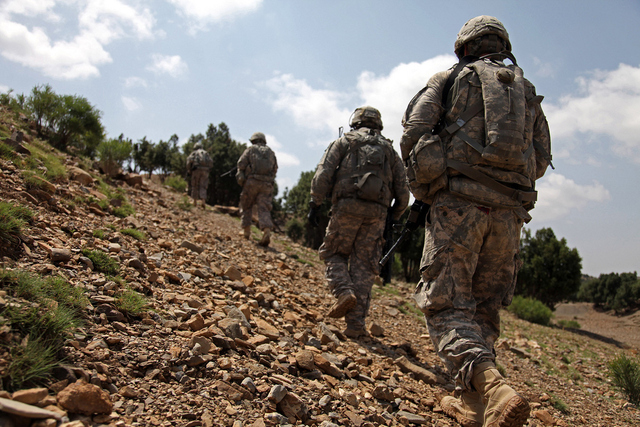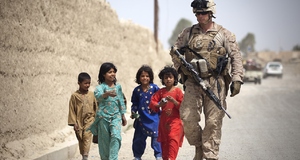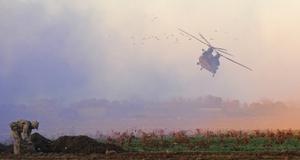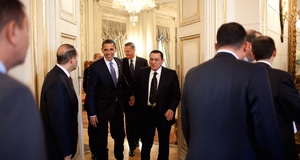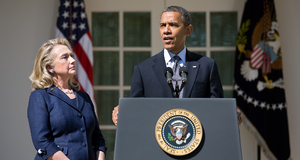From Cornell International Affairs Review VOL. 4 NO. 1Obama and AfghanistanThe Obama DilemmaAs Obama’s first year in office drew to a close, Afghanistan was fast becoming his most intractable and significant challenge as president. Politically, he was increasingly at odds with his Democratic Party base. If he hadn’t agreed to military requests for more troops, he would have risked a tremendous civilian-military rift; since he did agree, he risked being compared to Lyndon Johnson in Vietnam. In his campaign, Obama said he would end the “bad war” in Iraq and resource the “good war” in Afghanistan. He promised early in his presidency to focus not on unrealistic objectives but rather on eliminating the threat posed by Al Qaeda. Recognizing that Pakistan was as big a problem as Afghanistan (since Al Qaeda has largely left its camps there to take up residence across the border), he developed a strategy for thinking about these two countries in tandem. And he told the American public that the war was one of “necessity.” But by fall, he realized that he was being asked to send more troops to a conflict whose objectives had once again grown. To eliminate Al Qaeda and prevent the Taliban’s return was not just about eliminating bad guys and retaking territory; it was, as it was in the Bush years, about winning hearts and minds. McChrystal argued that the United States had to show the population why it should support the American-led effort. That meant protecting Afghans, and helping Afghanistan create an effective government. It meant shoring up the government of Pakistan and rooting out corruption there or risk facing a backlash from the population. But it doesn’t take a realist to recognize how high a bar that is. Even if one isn’t trying to build Switzerland in the heart of Central Asia, the prospects of a stable, effective central government emerging in the poorest country on earth even with significantly more numbers of American troops are slim at best. General Stanley McChrystal, former Commander of the International Security Assistance force in Afghanistant, in a strategy meeting with American Ambassador to Afghanistan Karl Eikenberry and President Obama in December of 2009. In the midst of these dilemmas, Obama went to West Point on December 1, 2009 to lay out his strategy before the country, the allies, the Afghan people, and the world.15 The speech was the culmination of a review process that had involved national security deliberations at the highest level over several months, leading to charges by former Vice President Dick Cheney and others that the president was “dithering.” Obama insisted that in-depth discussion was necessary to come up with the right answers, and that seat-ofthe- pants decision-making in the previous administration had generated many of the problems he inherited. The president began his speech with his usual remarks: the war was legitimate, the Bush administration never provided sufficient resources, and the problem was growing worse. And then he delivered the results of his review: “As Commander-in-Chief, I have determined that it is in our vital national interest to send an additional 30,000 U.S. troops to Afghanistan. After 18 months, our troops will begin to come home.” It was a surge, but one that came with a time limit. The Afghan government would know that America was going to do more to reverse the momentum the Taliban had built in recent months, but there would be no “blank checks” or openended commitments. President Karzai was on notice that he had a limited amount of time to shore up the capabilities of his government to take responsibility for security. The president’s announcement helped him with different constituencies. By providing General McChrystal with most of the troops he wanted, Obama avoided a rift with his military leaders. By announcing a time frame for beginning to bring troops home, he signaled to his Democratic Party base that he understood the country could not afford to let the war drag on indefinitely. But the obvious contradictions in those core two sentences of the speech left him open to criticism from the left and right. For those in the Democratic Party who see the costs of the war as weighing down the American economy, the addition of 30,000 troops was unwelcome news. Meanwhile, many on the right believe that announcing a withdrawal date merely gives comfort to the Taliban that they can simply wait out the American presence. As Obama’s first year in office drew to a close, Afghanistan was fast becoming his most intractable and significant challenge as president. The problem is not just political. The argument that the United States has a vital national interest requiring it to send more troops but that it can begin to bring some troops home in July 2011 is contradictory. “I make this decision,” said the president, “because I am convinced that our security is at stake in Afghanistan and Pakistan.” If American security was at stake in December 2009, it will still be at stake in July 2011. The Karzai government is unlikely to be ready to begin standing on its own. The Taliban will continue its insurgency. If the war is still one of necessity, in which core interests are threatened, then the United States has to remain for as long as it takes. If America’s vital interests are not sufficient to require an indefinite commitment, and if there are fewer than 100 Al Qaeda operatives in Afghanistan, why does the United States need 100,000 troops there? It’s clear from what is known about the 2009 deliberations that the president was looking for ways not to accede to the military’s push for escalation and skeptical that counterinsurgency could succeed. Obama made clear to his advisers that he did not want an open-ended commitment and was trying to find an exit strategy. 16 And while at the end of the 2009 review process, Obama spelled out his Afghanistan strategy in a six-page memo to his civilian and military advisers, he told them that they would meet in December 2010 to assess the results and decide on the nature of the withdrawal timetable. Those like Clinton and Gates who supported more troops have emphasized that the July 2011 date was going to be conditions-based and that nothing hasty would occur. Meanwhile, Vice President Biden made clear on several occasions that he believed troops would be leaving as quickly as they had gone in. Thus the same debate that occurred before the December 2009 speech was inevitably going to occur before the December 2010 decision. Obama felt boxed in by the military in 2009, and he will undoubtedly feel the same way at the end of 2010. After all, his new commander in Afghanistan, Gen. David Petraeus (who replaced McChrystal after the latter was fired over remarks he and his staff made in an interview with Rolling Stone magazine), pushed hard to get the troop increase in 2009 and will continue to oppose a precipitous withdrawal. But Obama clearly wants to be seen as the president who ended the wars in Iraq and Afghanistan so that America can focus on its domestic problems. During his time in office, he has articulated the view that America’s power is limited and its financial resources constrained. He will combat threats, not because he believes he can eliminate them but to make problems manageable. And he will do so by working closely with other nations and international institutions in order both to make America a more responsible power but also a less burdened one. He may have talked about a war of necessity in 2009, but he has signaled that what he truly believes is necessary is the withdrawal. The question is whether politically he can find a way to get out of the country he said was a necessity to be in. Endnotes
Photos courtesy of:
Suggested Reading from Inquiries Journal
Inquiries Journal provides undergraduate and graduate students around the world a platform for the wide dissemination of academic work over a range of core disciplines. Representing the work of students from hundreds of institutions around the globe, Inquiries Journal's large database of academic articles is completely free. Learn more | Blog | Submit Latest in International Affairs |

